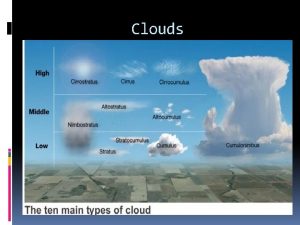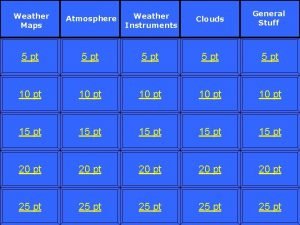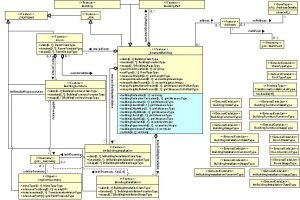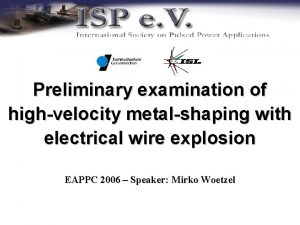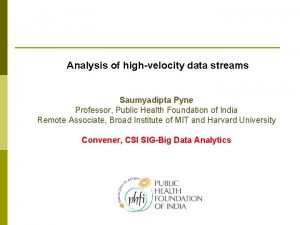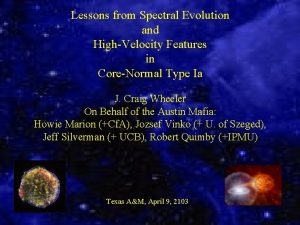Are HighVelocity Clouds a Common Feature of Star


























- Slides: 26

Are High-Velocity Clouds a Common Feature of Star Forming Galaxies? Wakker et al. (2000)

HVCs as Local Group Building Blocks? Grebel 1998

Compact HVC Typical HI Masses and Sizes • • • At 5 kpc MHI = 115 Mo d. HI = 60 pc n. HI = 5 x 10 -2 cm-3 MHI ~ 4. 5 D 2 (kpc) Size ~ 0. 4 deg 2 NHI ~ 1019 cm-2 At 50 kpc At 1 Mpc At 500 kpc 6 MHI=1. 15 x 104 Mo MHI=1. 15 x 106 Mo MHI=4. 6 x 10 Mo d. HI=600 pc n. HI=5 x 10 -3 d. HI=12 kpc d. HI=6 kpc cm-3 n. HI=5 x 10 -4 cm-3 n. HI=2. 5 x 10 -4 cm-3

HVC Distances • Direct methods

Direct Distance Determinations • Large complexes using halo stars • • • Complex A: 4 - 10 kpc Complex M: < 4 kpc Complex WE: < 13 kpc HVC 279 -33+120: < 50 kpc Complex C: > 6 kpc ~5 other HVCs: > 0. 3 kpc

HVC Distances • Direct methods • Ha emission measurements

Compact HVC Ha Detections Ha

HVC Distances • Direct methods • Ha emission measurements • Deep HI observations of groups

Deep Surveys of Groups Sculptor Group None to ~107 Mo (Putman et al. 2003) 2% of group, None to 3 x 106 Mo (de Blok et al. 2001) Same for Centaurus A n Small area in Local Group-like groups, 0 starfree HI objects to 7 x 106 Mo (Zwaan 2001) n Many other surveys of groups down to a few x 107 Mo have also found 0 (e. g. Lo et al. 1979, Dahlem et al. 2001)

HVC Distances • Direct methods • Ha emission measurements • Deep HI observations of groups and spiral galaxies • Lya absorbers

HVC Distances • Direct methods • Ha emission measurements • Deep HI observations of groups and spiral galaxies • Lya absorbers • Ionization constraints

Moore et al. (1999)

Incoming Star Formation Fuel? Wakker et al. (2000)

Smooth Accretion of Intergalactic Gas Bryan & Norman Bowen, Pettini & Blades (2002)

Mergers and Satellite Accretion Harding et al.

Galactic Fountain Material

Our Galaxy Putman et al. (2003)

M 81 Group (Yun, Ho & Lo 1994)

Leo Ring (Schneider et al. 1981)

Anomalous HI around galaxies • M 101 (van der Hulst & Sancisi 1988) • M 83 (O. K. Park et al. ) • FCC 35 (Putman et al. 1998) • NGC 2442 (Ryder et al. 2001)

NGC 2403 (lowest contour ~ 2 x 1019 cm-2; Fraternali et al. 2002)

Questions to be answered • Is there a relation between the presence of HVCs and a galaxy’s star formation rate?

SINGG = Survey for Ionization in Neutral Gas Galaxies (Meurer et al. )

NGC 1533 Ryan-Weber et al. (2003)

Questions to be answered • Is there a relation between the presence of HVCs • • • and a galaxy’s star formation rate? What type of environment are galaxies with HVCs found in? Are there near-by companions? How are HVCs related to the Ly-limit absorbers which also are commonly found in galaxy halos? And the O VI and lower column Lya absorbers which are often 100 s of kpc from a galaxy? How do HVCs fit into the CDM model of galaxy formation?

Target Selection • Northern extension of HIPASS (d = 2 – 25 o ) • Based on number of sources found in southern HIPASS, there should be ~900 sources • Stick to v < 2000 km/s, should be ~300 • ALFA resolution ~10 kpc at 10 Mpc • High-sensitivity mapping of the sample (to NHI~1019 cm-2, r~100 kpc) should provide information on the frequency and location of HVCs
 Mikael ferm
Mikael ferm Myrrh is mine its bitter perfume
Myrrh is mine its bitter perfume Why do clouds form?
Why do clouds form? Isolated feature combined feature effects
Isolated feature combined feature effects Feature dataset vs feature class
Feature dataset vs feature class A* and ao*
A* and ao* What do star events stand for
What do star events stand for Types of feature
Types of feature Highest common factors and lowest common multiples
Highest common factors and lowest common multiples Highest common factor of 48 and 60
Highest common factor of 48 and 60 The gcf of 12 and 18
The gcf of 12 and 18 Common anode and common cathode
Common anode and common cathode Highest common factors and lowest common multiples
Highest common factors and lowest common multiples Gcf of 48 56 and 72
Gcf of 48 56 and 72 Label the clouds
Label the clouds Why is a tornado dangerous
Why is a tornado dangerous Where do clouds come from
Where do clouds come from Nimbostratus clouds
Nimbostratus clouds Cirrus stratus cumulus cumulonimbus clouds
Cirrus stratus cumulus cumulonimbus clouds Clouds form
Clouds form Pt weather chart
Pt weather chart What causes clouds to form
What causes clouds to form Nimbostratus clouds
Nimbostratus clouds Dcoret
Dcoret Svensmark
Svensmark Above the clouds a berkeley view of cloud computing
Above the clouds a berkeley view of cloud computing Cassius clay clouds
Cassius clay clouds

















